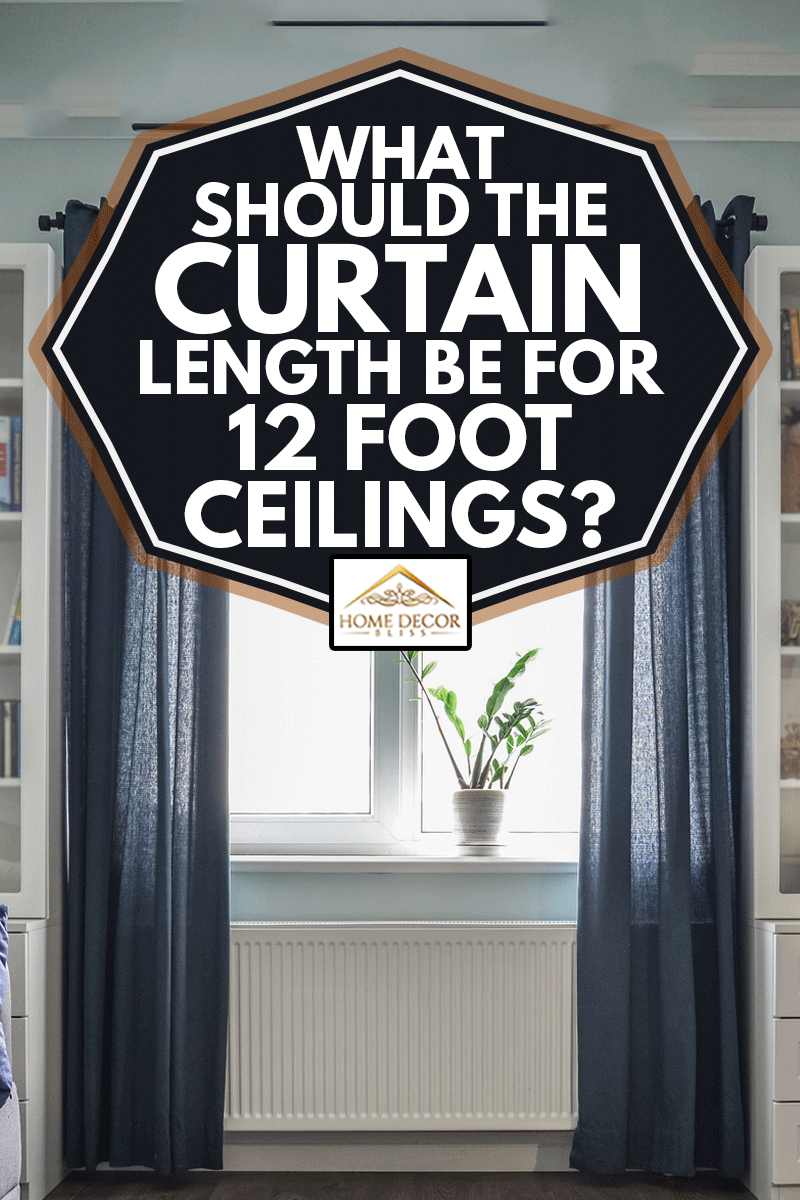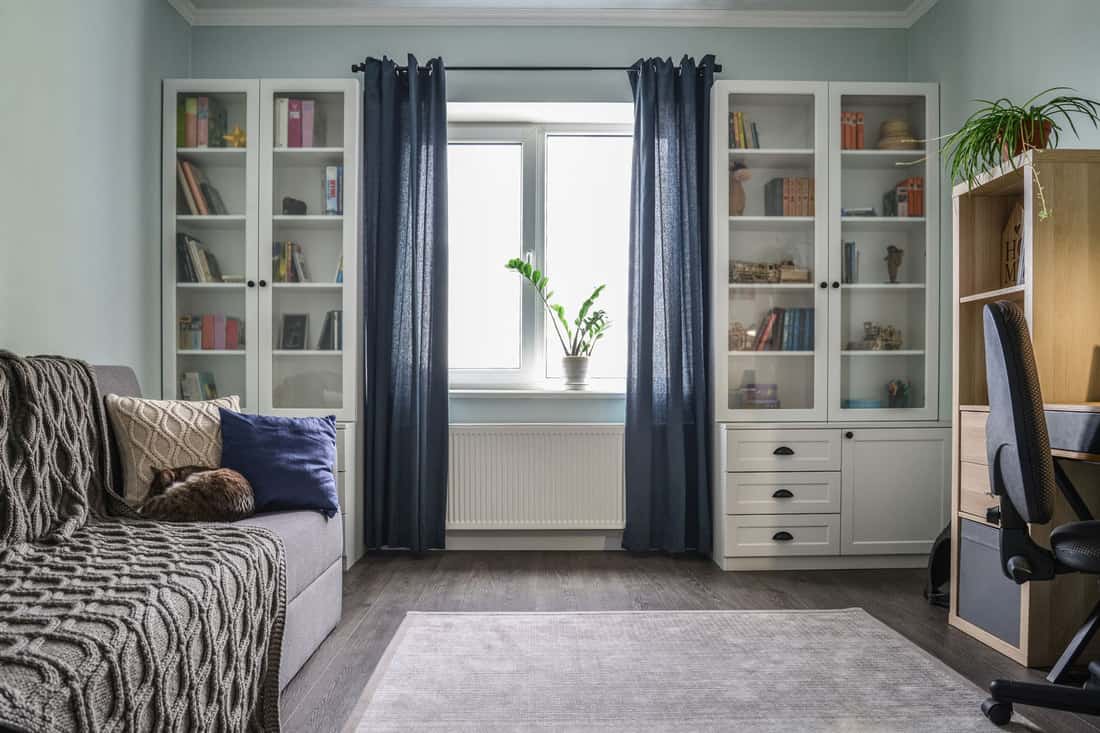Curtains can be tough to pick. There are so many factors - sound reduction, heat retention, light blocking, and more. And that's not even going into the looks - what color, what pattern, what style? Then, when you finally sort all of that out, you have to try to get the right size. Short curtains will look ridiculous, too big, and they drag on the floor, and how do you even know what size you need to begin? Who has time for all this? No worries, we've done all the research to simplify it - we know exactly what curtain length you need to fit your 12-foot ceilings.
The ideal curtain length for a 12-foot ceiling is 132 inches. A panel of this size will cover the distance between the floor, all the way up to one foot from the ceiling. Hanging curtains one foot from the ceiling is an easy way to place curtains that will always look good - it's not too high, it's not too low, it covers just enough area to draw attention to the windows without being over the top.
Keep reading to learn all about perfect curtain size and placement. This article will cover whether or not curtains always touch the floor, and why. It will also cover how high curtains should hang, where they look best, and more. If you aren't sure the best way to dress up your windows, this article will teach everything you need for your dream drapes.

Is It Okay For Curtains Not To Touch The Floor?
Curtains are meant to reach the floor - or at least come very close. Curtains, as a design feature, draw the wall and the floor together. They unify these features, and the right curtains can change the look of the room.
Similarly, when curtains stop abruptly, it tends to have a jarring effect. The eye is naturally drawn down the curtain's length to the floor - if the curtain doesn't complete the path, the eye doesn't know where to look next. It just makes the curtains seem isolated rather than incorporated into the rest of the room.
However, you can play with the exact length of curtains a bit. There are different styles, such as floating curtains. In this look, the curtains end, or float, just above the floor - an inch or less. This gives the curtains a clean, sophisticated style.
On the opposite end are puddle curtains. Here, the curtains are several inches longer than needed. The extra material, sometimes as much as 6 or 7 inches, puddles on the ground. This creates a look that is flowy and romantic, but it can also be less practical. For instance, vacuuming, dusting, or even walking around such elaborate curtains may be too much hassle for someone who isn't committed to the style.
You can learn more about different style options for curtains here.
How High Is Too High For Curtains?
Curtain rods typically hang somewhere around a foot from the ceiling. This isn't a hard and fast rule - but most windows stop between 16 inches and two feet from the ceiling. As a result, having the rod roughly one foot down is just a natural placement.
The most important thing is to make sure that the curtain doesn't hang too low. Don't set the rod too close to the window frame. If the curtain is pushed right against the frame, it looks crowded and off-center. Typically, this will also leave an uneven gap of space between the ceiling and the window.
Low curtains also make rooms look smaller. When the curtain is low, the ceiling seems low as well. To avoid a cramped room, it's better to go higher. This makes the ceiling and walls appear taller. If you want, you can even hang curtains from the ceiling.
However, in a 12-foot room, the walls are already pretty high. You want to be careful that you don't go overboard, which can leave the ceiling completely out of touch with the rest of the room. As a general rule, splitting the space over the window is a guaranteed look that always works. For example, if there are two feet of space between the window and the ceiling, place the rod right in the middle at the one-foot mark. This is balanced, pleasant, and almost always a good choice.
How High Up Should Windows Be?
Once, there was a reasonably clear standard for home construction. Walls were typically 8 feet high, which meant that doors and windows could also follow a corresponding standard. For example, on an 8-foot wall, windows would generally come as either 42 or 48 inches. While this offered less variety in available choices, it did simplify things.
However, people grew tired of having a lack of options. More and more, people want to pick unique or individualistic items that reflect their preferences and style. As a result, newer homes are built with walls in various sizes, like 9, 10, or even 12 feet high. For this same reason, there's also no end to the possible choices for windows.
Window size and placement do depend on a few factors, which include:
Other Wall Additions
The simplest rule to keep in mind? If this is a window right next to a door, you may want it hung so that the top of the door and window match up. When there are several elements are in a row but not aligned together, it looks sloppy and out of place. However, when the window is on a wall by itself, there's a bit more freedom to place it wherever you like.
Header
All windows need a header between the ceiling and the window. The header is part of the home design. It helps support the weight of the roof, and it's vital to safe construction. A structural engineer determines the exact size of the header based on other construction factors.
It's never less than 10 inches and is often larger. For special designs, like floor to ceiling windows, it's possible to get around the rules of a "typical" header with special tricks of engineering. However, it will drive the final price up.
Furniture Placement
This is more of an aesthetic factor than an actual engineering law like the header, but it's still important for the home's overall functionality. Windows typically aren't closer to the floor than about three feet. This leaves an area to place furniture but still not obstruct the window view.
After all, what use is a window if the couch blocks it? Or one that's too low to see out of from most viewpoints? Going too close to the ground makes the windows - an expensive addition to your home - less useful, and who wants that? For this reason, standard windows are rarely lower than three feet from the floor. Of course, there are exceptions for unique windows such as floor-to-ceiling or sidelight windows by a door.
Leftover Space
Once you know what space is blocked off at the top for the header and at the bottom for furniture placement, you know your maximum window size. Whatever space you have left can be as much (or as little) window as you want. For example, a 12-foot wall has 9 feet available once you account for the three feet of "no window space" at the bottom. If your header is 18 inches, that now leaves you with seven and a half feet, or 90 inches.
In Closing

We sometimes add affiliate links and content that was curated and created by our team with the help of advanced ai tools to help showcase the best design styles.
For curtains on 12-foot walls, use 132-inch curtain panels. This size covers the floor when hung from one foot below the ceiling. Hanging curtains one foot below the ceiling works in most rooms and with most windows. It's better to leave extra room above the window frame with a high curtain rod. The alternative, a curtain rod that is too low or too close, can make a room seem small or cramped.
